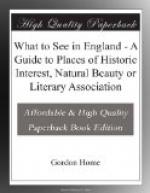When Cowper and his friends moved to Olney they lived in the old-fashioned regular fronted house illustrated opposite. Here Cowper is said to have amused himself with his hares and in the making of boxes and tables. He was also interested in the bees in the old-fashioned garden at the back of the house, where one may still see the little rustic summer-house in which John Gilpin and some of the Task were written. The house now contains a Cowper museum, and visitors thus have an opportunity of seeing the parlour and other rooms, besides many other interesting objects connected with the poet. His great friend at Olney was the Rev. John Newton. They were constantly together in their walks, in their homes, and at church, and both wrote a number of hymns.
[Illustration: Thornborough.
COWPER’S HOME AT OLNEY.
The house now contains a Cowper museum.]
WANTAGE AND THE COUNTRY OF ALFRED THE GREAT
=How to get there.=—Train from Paddington. Great Western Rly. =Nearest Station.=—Wantage Road. =Distance from London.=—60-1/2 miles. =Average Time.=—Varies between 1-1/2 to 2-3/4 hours.
1st
2nd 3rd
=Fares.=—Single 10s. 0d. 6s. 4d. 5s.
0-1/2d.
Return
17s. 8d. 11s. 0d. 10s. 1d.
=Accommodation Obtainable.=—Good posting
and hotels. “Bear
Hotel” and “Blue Boar.”
The chalk ridge in the north of Berkshire is rich in memories of Alfred. First in importance is Wantage, a peaceful town at the foot of the hills, and famous as the birthplace of the great king. There is a statue by Count Gleichen in the wide market-place representing Alfred with a battle-axe and a charter in his hands. The church is a fine example of Early English architecture, and interesting besides as the burying-place of many famous Fitz-warens, among them Ivo, whose daughter married Richard Whittington, Lord Mayor of London. Dr. Butler of The Analogy was born in the town, and the house is still to be seen.
Leaving Wantage, one may go along the breezy downs to Uffington Castle, a large fort, presumably of British origin. It was one of many similar forts along the Roman way called Ichenilde Street, that stretches straight as an arrow along the whole ridge. Near the fort is the famous White Horse cut in the chalk, which, since its recent cleansing, gleams brilliantly from the hillside. It was cut out to commemorate the magnificent victory of Ethelred the Unready and Alfred over the Danes at Ashdown in 871. Readers of Tom Brown’s School Days will recall the story of the Berkshire revels in 1857, when the scouring of the Horse took place. Judge Hughes was born here, under the shadow of the downs, and near by is the round hill where tradition says St. George slew the dragon.




